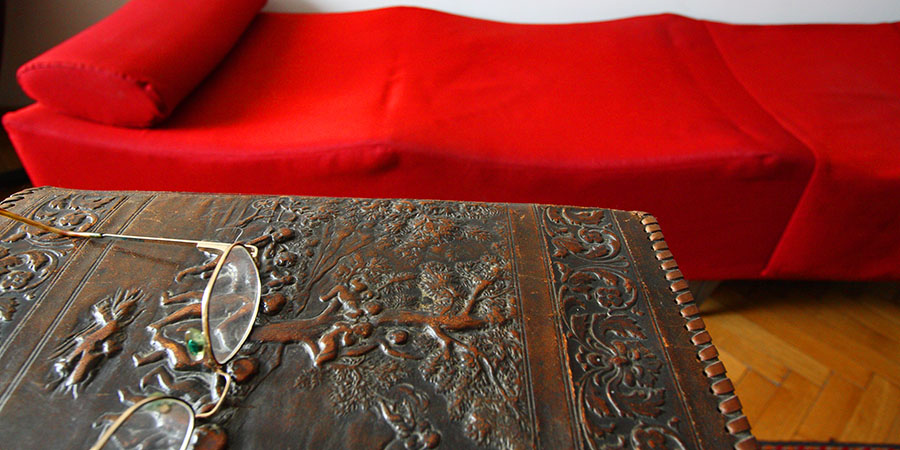Dove le parole si distendono
Più che di fotografie che ritraggono lettini psicoanalitici, si tratta qui di fotografie della relazione che si svolge tra il lettino e la poltrona dell’analista. E’ qualcosa di cui mi sono accorto via via che il lavoro prendeva piede: la mia attenzione andava soffermandosi non tanto unilateralmente sull’oggetto lettino, quanto piuttosto sul dialogo e sulle modalità attraverso cui nasce la relazione tra lettino e poltrona, il volo che tale relazione può prendere, i luoghi che può raggiungere. Sono foto delle impronte che analista e paziente talora imprimono anche fisicamente, delle relative simmetrie relazionali che divengono a volte simmetrie di dettagli fotografici di lettino e poltrona.
Il processo del fotografare ha in sé una forte vicinanza con i momenti di quanto accade in analisi ….abbiamo immagini da “catturare” prima che scappino tornando nell’inconscio…..e poi da “sviluppare”…. e infine da “stampare”.
Questa serie di foto è nata nel mio studio come tentativo di “fotografare” la meraviglia che quotidianamente sentivo di fronte alla “impronta” che ogni giorno i pazienti ed io stesso
lasciavamo sul lettino e sulla poltrona. Successivamente ho deciso di andare a visitare e fotografare i luoghi dell’incontro psicoanalitico usati dai miei colleghi, chiedendo loro di scrivere un breve testo a commento della loro stanza/foto. Sono poi approdato alla casa di Freud e infine in stanze sognanti incontrate per caso fuori dai luoghi della psicoanalisi. In alcune foto un oggetto simbolico della stanza è stato da me avvicinato al lettino in modo “artificiale”. Dalla relativa neutralità di ogni studio ho talora preso un appiglio di fantasia , che potremmo chiamare “correlativo oggettivo”, come diceva T.S. Eliot: “una serie di oggetti, una situazione, una catena di eventi pronta a trasformarsi nella formula di un’emozione particolare”. O quello che nel lessico bioniano potremmo anche chiamare l’equivalente di un “fatto scelto”. Come i giocattoli che i bambini portano con sè all’asilo da casa, anche gli analisti hanno spesso in studio degli oggetti che fanno da tramite tra i propri sentimenti e quelli del paziente. Si tratta magari di un quadro, di una maschera africana, di una bambola indiana o anche solo di un cactus pieno di aculei.
Where the words stretch out
More than pictures portraying analysts’ couches these are photographs of the relationship between the couch and the analyst’s armchair. I realized this while carrying out this project: instead of focussing just on the couch as an object, my attention lingered on the way in which a dialogue arises between the couch and the armchair, the flight this relationship can take, the places it can reach. These are pictures of the traces that analyst and patient leave behind, sometimes also physically, pictures of the symmetries in the relationship, which sometimes translate into the symmetry of some details of the couch and the armchair.
The process of photography itself is extremely close to the process of analysis… there are images to be “captured” before they escape, running back into the unconscious… and one has to “develop”… and finally “print” them.
This exhibition originated in my consulting room as an attempt to “take a picture” of the feeling of wonder I have every day when looking at the “trace” left on the couch and armchair by the patients and myself. Later I decided to visit and record in pictures the places where my colleagues met their patients for psychoanalysis. I also asked them to write a small text on their consulting rooms and on my pictures of them. I ended up in Freud’s house and finally in dreaming rooms found by chance, away from the places of psychoanalysis. In some pictures I have “artificially” moved some symbolic object of the consulting room towards the couch. Out of the relative neutrality of every room I have sometimes picked a detail that caught my fancy. These objects could be defined, in T.S. Eliot’s terminology, as “objective correlatives”: a series of objects, a situation, a chain of events ready to turn into the formula of a particular emotion. If, instead, one wants to use Bion’s lexicon, then these objects are the equivalents of a “chosen fact”. Like children who take with them some toys from home to nursery school, so analysts often keep in their rooms objects that bridge the gap between the patient’s feelings and their own. It may be a favourite book, an African mask, an Indian doll, or just a thorny cactus.


